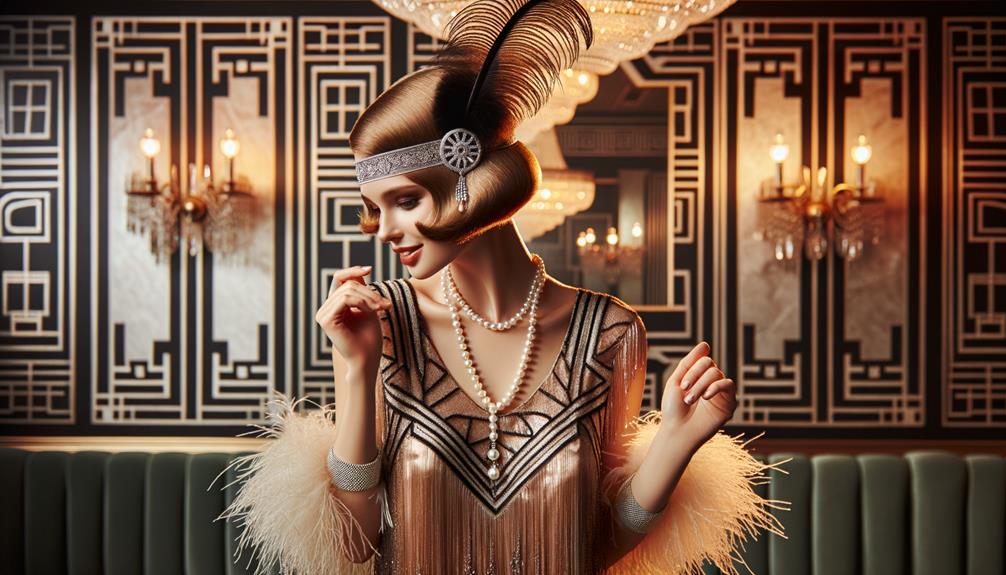Jeans have undergone an intriguing evolution throughout the 20th century, reflecting the cultural shifts and personal rebellions of the times. Originally born from the hardy fabric of workwear, jeans started as symbols of rugged perseverance. The mid-1900s saw a twist, with youth donning denim as emblems of defiance against the status quo. By the '70s and '80s, designer labels transformed jeans into high fashion, adding layers of sophistication. Hip-hop in the '90s then made them a canvas for bold self-expression. Today, jeans blend rebellion with elegance, continually reinventing themselves. There's an unspoken promise in every stitch and rivet, waiting to unfold in the story of denim's enduring evolution.
The Birth of Jeans
How did a simple fabric from France and Italy become an integral part of American culture? The story of denim is one of chance and innovation, woven through history and creativity. In the late 17th century, weavers in Nîmes, France, accidentally crafted a resilient fabric called 'serge de Nîmes.' Meanwhile, in the busy port city of Genoa, Italy, a similar fabric emerged, leading to the term 'jeans' from 'bleu de Gênes.'
Fast forward to 1853, when German immigrant Levi Strauss arrived in San Francisco, seeking opportunity in the growing dry goods business. He supplied durable denim fabric imported from Europe to his eager customers. One of them was Jacob Davis, a visionary who saw potential in reinforcing denim with copper rivets. Together, Strauss and Davis patented this ingenious design in 1873, forever altering the landscape of workwear.
From these humble origins, denim overalls emerged in the 1870s, evolving into the first pairs of jeans by the 1890s. This simple yet groundbreaking garment would transcend its practical roots, becoming an enduring symbol of American culture and innovation.
Workwear to Fashion
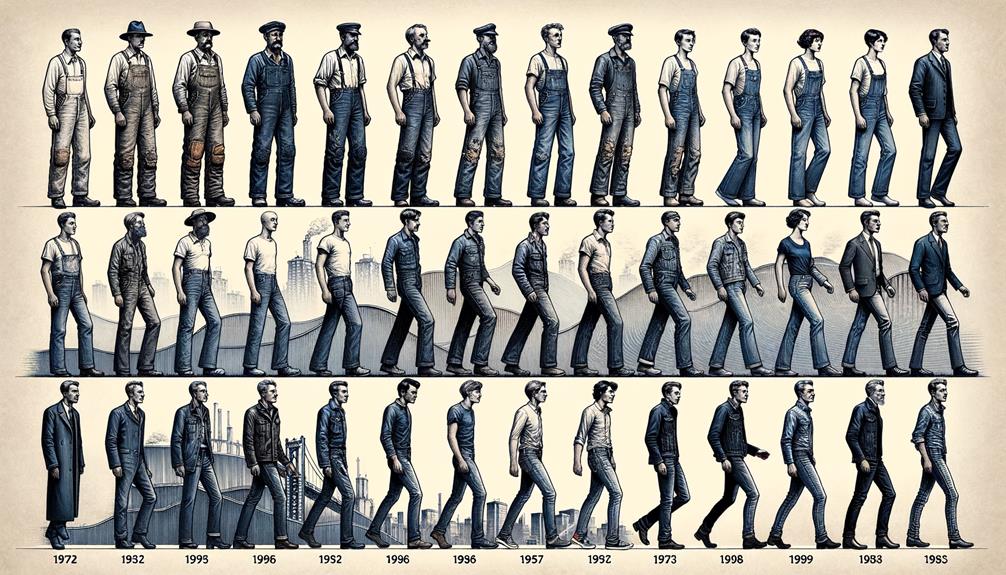
Denim's journey from its rugged roots in workwear to becoming a symbol of cultural expression and high fashion is a remarkable story of transformation. In the 19th century, jeans were born out of necessity when Levi's crafted the first riveted denim waist overall in 1873. This sturdy fabric, once worn by miners and cowboys, gradually became a beloved part of Americana. Over the decades, denim transcended its humble beginnings, becoming a canvas for Western wear and casual attire.
By the mid-20th century, the raw, unrefined texture of denim began to signify a sense of rebellion and freedom. It wasn't just clothing; it was a statement. The selvedge denim, with its meticulous craftsmanship, symbolized a break from convention and a nod to authenticity. Japanese brands elevated the denim craft, setting new global standards.
As the century turned, jeans evolved further, embracing the world of luxury fashion. High-end brands like Gucci transformed denim into a canvas for opulence, offering pieces that exuded exclusivity and artistic flair. From workwear to fashion, denim's legacy is one of endless reinvention, capturing the spirit of innovation.
Mid-Century Rebellion
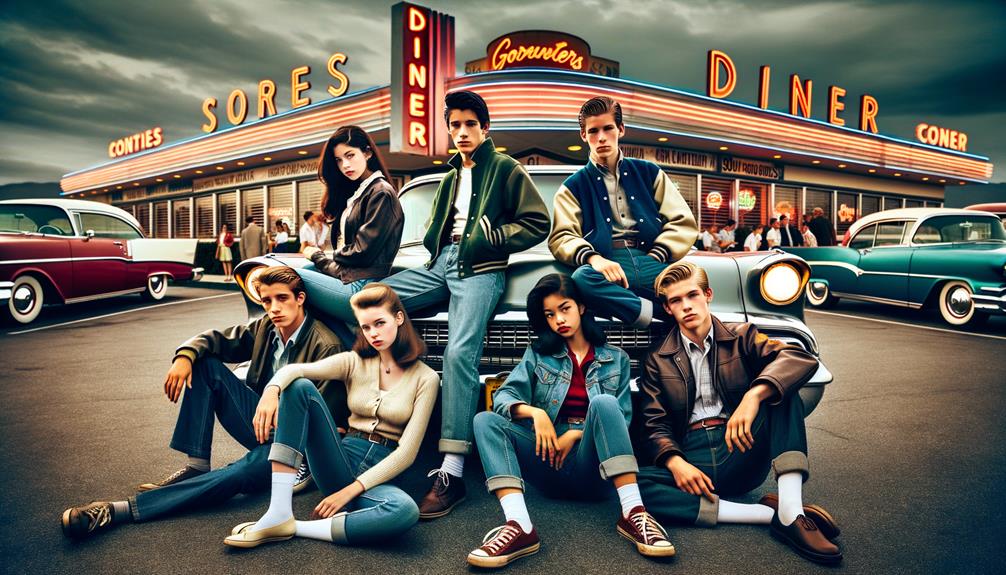
When I think about the rebellion of the mid-20th century, I picture the iconic image of youth donning denim as a symbol of defiance. Figures like James Dean and Marlon Brando didn't just wear jeans – they wore an attitude, a protest sewn into every thread. As rock and roll gained momentum, jeans became a silent anthem for those who challenged the status quo and refused to conform.
Youth Culture Shift
In the 1950s, jeans transformed from ordinary workwear into a bold statement of youthful defiance, challenging the rigid conformity of the era. They became the go-to choice for brands aiming to capture the rebellious spirit embodied by pop culture icons like James Dean and Marlon Brando. These stars, with their smoldering gazes and denim-clad frames, turned jeans into a symbol of youth rebellion. It wasn't just about fashion; it was a declaration of independence, a sartorial middle finger to the establishment.
It's fascinating to see how actors like James Dean and Marlon Brando, through their on-screen personas, ignited a cultural revolution. Their denim-clad defiance spoke volumes. In those days, jeans were often banned in schools, theaters, and restaurants, seen as a harbinger of delinquency. Yet, the more they were shunned, the more they were embraced by a generation yearning for change.
Ripped jeans became a symbol of defiance, customization, and individuality. Jeans were the uniform of a generation challenging societal norms. Denim was more than just fabric; it was an anthem of resistance.
Denim as Protest
Jeans became a symbol of defiance in the 1950s as rebellious teens embraced denim as a quiet act of resistance against societal norms. On-screen icons like James Dean and Marlon Brando cemented jeans as the uniform for those seeking to break free from constraints. Western films romanticized the rugged, untamed spirit, further solidifying denim's place in the cultural psyche as a representation of rebellion.
As denim's subversive power grew, institutions sought to control its use. Schools banned students from wearing jeans, perceiving them as a threat to order. Theaters and restaurants followed suit, casting denim as an outlaw in their pristine worlds. But the more jeans were outlawed, the more they became a badge of honor for the disenchanted, who saw the garment as a symbol of their nonconformity.
Designer Denim Emerges
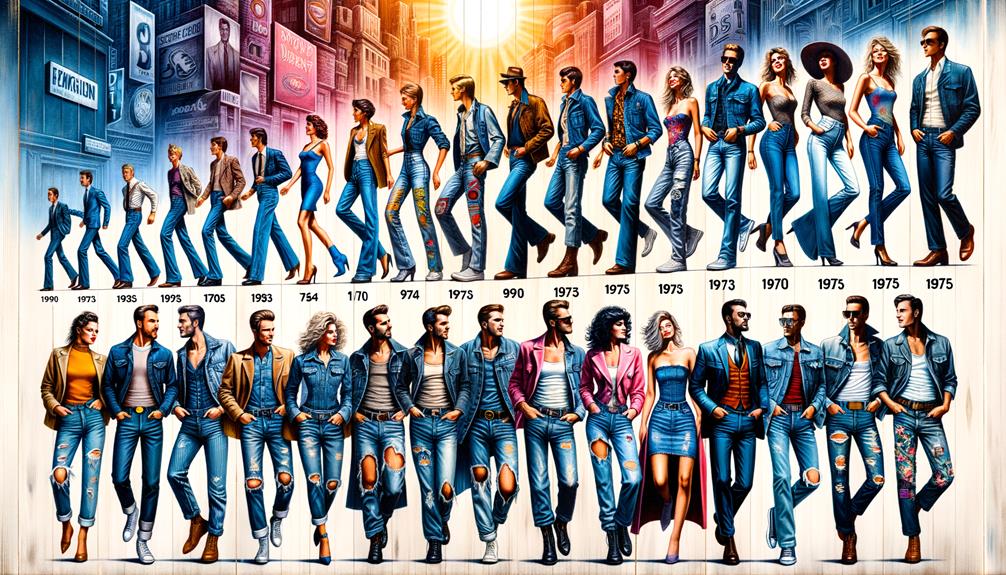
With Calvin Klein's bold move in 1976, jeans evolved from practical workwear into coveted high-fashion items and symbols of individual expression. His runway debut marked a turning point, transforming ordinary denim into premium brands and establishing jeans as a status symbol.
Over the years, other prominent designers like Armani, Jordache, and Guess jumped into the fray, each weaving their distinct narratives into the denim tapestry. Stonewash, acid wash, and ripped jeans emerged as trends that reflected the zeitgeist of their respective eras, like echoes of the collective cultural consciousness.
Three pivotal shifts stand out in this transformative journey:
- Designer Influence: Calvin Klein's innovation paved the way for high-end brands to redefine the meaning and perception of jeans.
- Trend Evolution: Changing fashion sensibilities were encapsulated in the rise and fall of denim treatments like stonewash, acid wash, and rips.
- Cultural Significance: Jeans transitioned from mere clothing to symbolic representations of a shifting cultural landscape.
The simple piece of denim has indeed encapsulated a rich and dynamic history.
Hip-Hop Influence
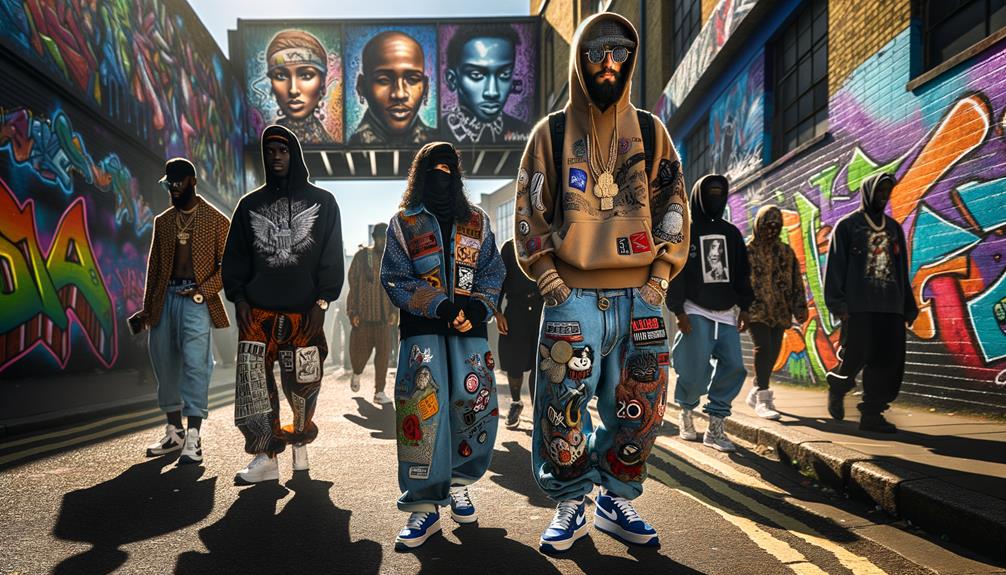
As designers elevated denim into the world of high fashion, hip-hop artists brought it to the streets, infusing it with raw, rebellious energy that echoed through oversized jackets and baggy jeans. In the late 20th century, denim became more than just fabric – it transformed into a cultural statement. The relaxed fit of wide-leg 'JNCO' denim jeans and the distressed, ripped looks captured the gritty essence of the urban landscape.
| Emotion | Visual Element | Cultural Impact |
|---|---|---|
| Rebellion | Ripped and distressed | Urban spirit |
| Confidence | Oversized jackets | Street fashion |
| Individuality | Bold graphics and logos | Personal customization |
| Unity | Baggy jeans | Hip-hop culture |
| Innovation | Contrasting indigo | Fashion evolution |
Denim trousers and jackets became canvases for bold graphics and logos, turning everyday wear into personal art. Hip-hop's influence on denim styles led the industry to new heights, with brands embracing this rough-edged yet innovative spirit. Fashion designers found inspiration in the grunge and hip-hop scenes, blending these elements into their collections. Jeans, rather than just workwear, became symbols of identity and expression. From the relaxed fit of baggy jeans to the meticulous customizations, denim told stories of defiance, creativity, and community. The streets became runways, and the world took notice.
Modern Denim Trends
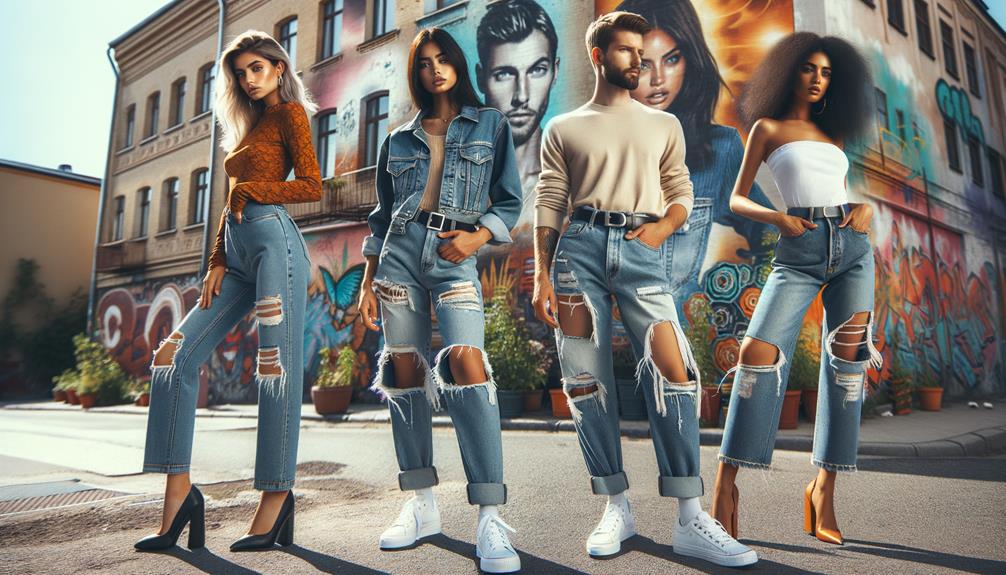
In today's fashion landscape, denim is a canvas for endless possibilities. We're seeing the comeback of low-rise jeans, a nod to the 90s and 2000s, but with bold new cuts and intricate stitching. Skinny jeans, once the hallmark of the early 2000s, now coexist with the resurgence of wide-legged styles, adding dramatic flair to street fashion.
The modern denim trends reflect a blend of rebellion and sophistication. Distressed and ripped denim echo the raw, edgy ethos of the 80s, while acid-washed pieces speak to a love for vintage revival. Meanwhile, designer jeans elevate these classic elements, merging craftsmanship with high fashion.
Key trends to watch out for:
- Flare and bootcut jeans: Offering a nostalgic yet fresh silhouette, flattering for all body types.
- Sustainable denim: Innovative eco-friendly materials and production processes.
- Customization: From hand-painted designs to tailored fits.
Denim has evolved beyond just a fabric; it's a medium for self-expression and innovation. Whether it's the timeless appeal of bootcut jeans or the edgy charm of distressed styles, denim remains an ever-changing canvas for fashion.
Frequently Asked Questions
How Did Jeans Evolve Over Time?
Jeans have come a long way from their humble origins as sturdy workwear. Over time, they've transformed into icons of youth culture, fashion statements, and reflections of societal shifts.
In the early days, jeans were worn by laborers and miners, known for their durability and practicality. But as the decades passed, they became symbols of rebellion and individuality, embraced by subcultures like the beat generation and the counterculture movement of the 1960s.
Today, jeans have transcended their utilitarian roots, becoming a staple in high-fashion collections and a go-to choice for people of all backgrounds. Their versatility and ability to adapt to different styles and trends have made them a ubiquitous part of our wardrobes, mirroring the diverse aspirations and identities of those who wear them.
What Was Denim in the 20TH Century?
Denim in the 20th century was a story of evolution, blending its workwear origins, counterculture movements, and high fashion into a global phenomenon.
In the 1950s, the rebellious teenager clad in jeans became a symbol of defiance. Denim transcended its utilitarian roots, becoming a canvas for self-expression and cultural shifts.
From the rugged dungarees of factory workers to the iconic blue jeans of the counterculture, denim wove itself into the fabric of popular culture. As decades passed, it ascended from the streets to the runways, transforming into a high-fashion staple celebrated by designers worldwide.
The versatility of denim allowed it to adapt to the changing tides of the 20th century, reflecting the evolving social and cultural dynamics of the time. It became a unifying thread, connecting workwear, youth rebellion, and haute couture in a compelling narrative that continues to captivate global audiences.
Were Jeans Popular in the 20s?
In the 1920s, jeans weren't yet a fashion staple. They were rugged workwear, worn by the working class. Yet, there's a hint of rebellion and individuality starting to emerge – a glimpse of the transformative journey denim would soon undertake.
Jeans were not widely embraced as a fashionable item during the 1920s. They were primarily utilitarian, worn by manual laborers and those in blue-collar professions. However, there are signs that denim was beginning to take on an air of nonconformity and personal expression, foreshadowing the iconic status it would later achieve.
Did They Have Jeans in the 1900s?
Jeans have been around for quite some time. Even in the early 1900s, these rugged workwear garments were becoming more widespread. They started as hardy pants favored by laborers, miners, and cowboys, but gradually transitioned into a cultural icon. Over the decades, jeans evolved from purely functional attire to a canvas for self-expression and fashion. It's fascinating to see how a simple piece of clothing can take on such significance and become woven into the fabric of history.
Conclusion
Jeans have come a long way since their humble beginnings as workwear. Over the course of the 20th century, they've evolved into a fashion staple worn by people from all walks of life. It's remarkable to think that a staggering 450 million pairs are sold each year – a testament to their enduring appeal and versatility.
Jeans have a unique ability to blend rebellion and comfort. They've become more than just clothing; they're a symbol of our evolving identity, transcending generations. Each pair tells a story, reflecting the wearer's personal style and experiences.
From rugged denim worn by laborers to the high-fashion iterations sported on the runway, jeans have woven themselves into the fabric of our culture. Their adaptability has allowed them to seamlessly transition from the workplace to the streets, making them a wardrobe essential for many.
As we reflect on the journey of jeans, it's clear that they've become more than just a piece of clothing. They're a canvas upon which we can express ourselves, a canvas that continues to evolve alongside the changing times.



